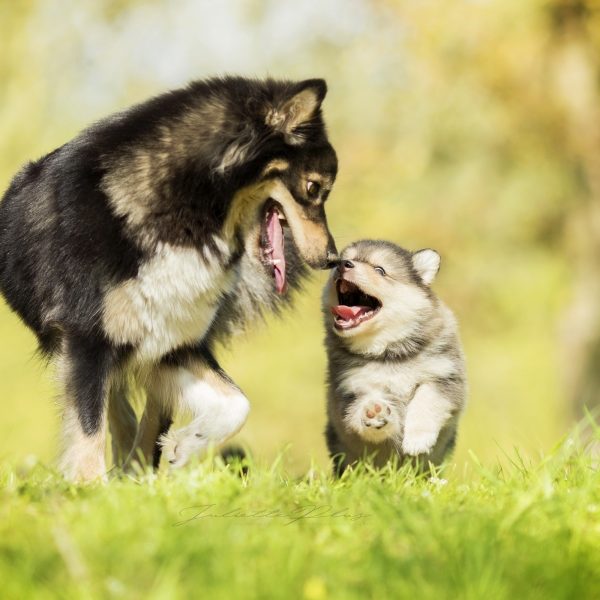How to Introduce a New Puppy to Your Dog
 Adding another canine member to your family is so exciting! A new puppy promises to be a companion to you, a playmate to your kids, and a friend to the dog you already have. But the process to introduce a new puppy into your household is not without its obstacles and uncertainties.
Adding another canine member to your family is so exciting! A new puppy promises to be a companion to you, a playmate to your kids, and a friend to the dog you already have. But the process to introduce a new puppy into your household is not without its obstacles and uncertainties.
If you already have a dog, one of the most important parts of integrating a new pup into your home life is introducing him to your dog. As a note: if you’re thinking about getting a puppy and your current dog tends to be aggressive, then you should probably seek the advice of a trainer to manage this introduction.
Here are a few tips to help get you through this process:
Neutrality is Key
You want the space where you introduce the two dogs to be as neutral as possible. As you probably know, dogs have very territorial instincts.The presence of a new dog on their home turf can make them feel very defensive. They may behave aggressively, even if that isn’t normal for them.
So, to prepare your home for the presence of the new pup, clear away any toys, bones, beds, and other paraphernalia that “belongs” to your current dog. This will make him less stressed out when the new pup is there. This is also a good tip for introducing a new dog to other pets.
Choosing an Approach
You’ll have to decide where you feel most comfortable introducing the dog and the pup, but these are two popular approaches. You can introduce the dogs in a quiet and open space away from your home, such as a park. Or, if you prefer the more cautious route, you can start in your home and let them get used to each others’ smell before they meet face-to-face in a neutral area.
Visual Introduction First
If you’re going the visual introduction-first route, basically any outside location besides your own yard will do. If your dog likes the park or the dog park, that can be a good option. Bonus points if it’s within walking distance of your house – because after the dogs meet, you can walk them home. But, you can even conduct this meeting in your neighbor’s yard.
Bring the dogs to the designated spot separately. When they meet, you’ll want to make sure they’re not straining on their leashes. Keep them loose so that the dogs stay as relaxed as possible. They’ll sniff each other and then you should see signs of the puppy submitting to the adult dog – he might roll over and expose his belly!
If you sense tension between the dogs or if they’re showing signs of aggression, gently separate them and calm them with play and treats. When the dogs have been successfully introduced, walk them home. Your older dog should be let off the leash, but the pup should be kept leashed as you allow him to explore the rooms. Monitor the dogs’ interactions closely for the first few weeks.
Direct Introduction into House
If you choose to introduce the pup directly into your home, you should prevent the dogs from seeing each other at first. Keep them each in a cage in different areas of the house and introduce them by smell. This will make their actual meeting less of a shock, especially for your older dog. While they’re in separate cages, exchange items between the two of them.You can swap toys that they’ve been chewing on or pieces of bedding.
The next step is to let them each walk around the house alone while the other is outside. Comfort your older dog if he seems disturbed by the smell of the new pup, and soothe the pup if being in another dog’s space scares him.
Then, you’ll take the dogs to a neutral area, and finally introduce them face-to-face. They’ll already know each other by scent.
Match Energy Levels
Another tip: if your dog is older, you may want to let the pup get some exercise before the introduction so he’s a bit tired. This will bring them closer to the same level, energy-wise, and may reduce your older dog’s irritation. It may make the meeting go more smoothly overall.
During this sensitive time for both dogs, pay attention to how they are feeling. If they seem agitated or upset, calm them with extra playtime, treats, or doggie massage.
